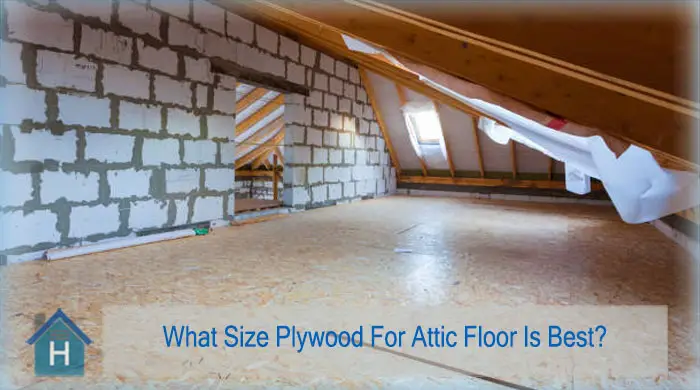Picking the right size of plywood is essential when you’ve planned to install a new floor in your attic space. That way you can confirm the safety and strength of the floor to walk on.
To figure out what size plywood for attic floor is ideal, you’ll need to think about the spacing of the floor joists and the load capacity of the floor.
Nearly all experts advise using 3/4 inches depth of plywood to use for the attic floor. Sometimes you might need to use 1/2 inches or 5/8 inches of plywood for the same purpose.
Keep on reading to discover the details of these sizes!

What Size Plywood For Attic Floor Is Best?
To know what size plywood is used for the attic floor, you’ll need to focus on the space and weight a floor requires to get support. Based on these 2 factors, let me explain this topic below:
3/4 Inch Plywood
Most experts suggest using 3/4″ plywood to make the attic floor with 16″ on center joist spacing. It’s a general rule of thumb to use thicker plywood if the on-center gap seems further away.
That means if the ceiling joist is spaced at a good distance, you’ll need to pick plywood that is thicker than 3/4″ in size.
However, it’s worth noting that this rule may not always work! For instance, if the ceiling shape is complicated and you plan to place a good amount of load on the attic floor, it’s essential to pick thicker and more solid plywood.
1/2 Inch Plywood
If you are wondering what thickness plywood for the attic floor is ideal to use for a large area, the 3/4″ size might not be a good choice.
The reason is that the 3/4″ plywood might feel good and stiff but it’s heavy. If it’s about simple walkway or a floor that doesn’t contain loads, you should use 1/2″ plywood to make an attic floor with 24″ or less on center joist spacing.
However, if you use the attic floor to store or add a room where one will live, it is suggested to count the load of the area as well as the plywood weight.
After considering these, you can find the right size. This way you can ensure existing framing will support the attic floor.
5/8 Inch Plywood
For the attic floor, the 5/8″ size of the plywood is ideal with a span rating of at least 16″ on the center floor joist.
This depth would work if your intent is to make the attic floor for normal use with no heavy loads to place.
However, if you plan to use the 4′ x 8′ attic floor for storing bulky items or other purposes, it’s best to go with higher-depth plywood or place layers of the 5/8″ plywood. This will help add both strength and structure to the floor.
Type Of Plywood For Attic Floor!
If you are wondering which plywood is best for the attic floor instead of drywall or OSB board, just go with the tongue and groove type.
Since real wood is costly, most suggest using this type of plywood to get the job done without hurting the home.
The plus point is that it takes less time to install and adds good strength. This kind of plywood also gives tighter joints to prevent the risk of gaps. Also, you’ll get better insulation by preventing moisture and air leaks.
But that doesn’t mean the tongue and groove plywood doesn’t hold the downsides. It often seems less flexible. Plus, this kind of plywood is hard to repair.
In general, for attic floor jobs, the tongue and grove plywood is the best choice!
Read: How to Hide Attic Door in Ceiling
Ending Note
As it is a matter of safety to walk in or put things on the floor, you should know what size plywood for attic floor. A slight mistake in sizing can cause disaster to the home unless you are doing it with the help of a skilled builder.
It would be better if you consult with an expert before trying anything with attire space. This kind of project requires great knowledge to design and build the floor.
Hope you get the exceptional attic floor!
This is Autem Decker. Main Author of ‘TheHomeDigs‘. You may not find her on the list of top 10 contemporary Canadian interior designers, but everyone who knows her says she was born to be an interior designer.
She makes her plan in her head and draws them in her years-old diary with a note in the corner. The way she plays with color and shape amazes us.
Connect Her On – Twitter